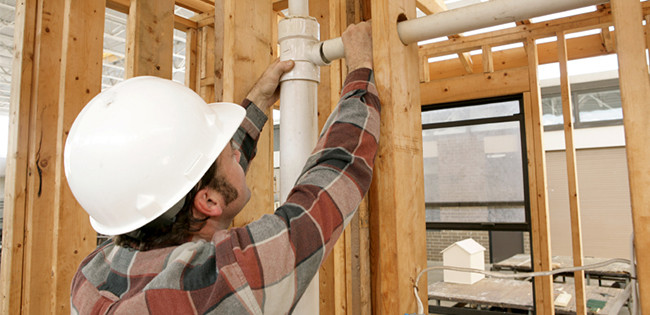
Generally, employers must set up workers compensation coverage and other required coverages – depending on the jurisdiction – for anyone working as a statutory employee. That is, employers are directly responsible for all workplace injury claims of anyone reporting to management and drawing an hourly wage or salary, from which taxes are deducted.
Construction managers, therefore, must obtain workers compensation coverage for their own staff. They do not, however, set it up for subcontractors, nor the employees of subcontractors.
In a recent Indiana court case, though, an injured worker decided to test the limits of the traditional arrangement. According to reporting by ConstructionRisk.com, the worker was working at a stadium construction site as an employee of a subcontracted firm, Baker Concrete Construction, Inc. She was injured by a falling block of wood, which struck her in the face and hand. Although she had no employment contract with the general contractor overseeing the contract, Hunt Construction Group.
The plaintiff’s theory was that Hunt had an overall responsibility to ensure the safety of the workplace.
However, Hunt did not have any kind of contractual relationship with Baker Concrete Construction. Hunt’s only contractual relationship was with the site owner.
An Indiana appeals court sided with Hunt. There was nothing in Hunt’s contract that granted them the responsibility for overall worksite safety, much less anything in their contract that granted them the authority to intervene in other subcontractors’ operations, not affiliated with Hunt, to ensure workplace safety. Yes, Hunt periodically conducted workplace safety audits for the protection of their own employees and subcontractors. But the courts held that that did not imply that they had a responsibility for other workers wholly unrelated to their operation just because they were on the site – at least, not to such an extent that it rose to the level that Hunt bore financial liability for the injury.
According to the judgment, the courts looked specifically at the contract that Hunt had with the site’s owners. There was nothing in their contract that made them the overall safety director of the site, nor anything other than the geographical location that connected them to the injured worker.
The court also noted that both the injured worker and the employee that dropped the piece of wood that injured her were both Baker employees, not Hunt employees. The appeals court unanimously ruled that Hunt did not have a duty to provide the injured worker with a safe workplace. Maybe somebody else did – and a majority of the panel ruled that the worker could possibly seek remedy from Baker, under workers compensation laws. But not for Hunt.
Be Careful With Sweeping Responsibilities for Safety
If you are the construction manager of a worksite, look closely at the contract. Are you signing on as the overall safety director for the worksite? Is there anything in the contract appointing your company as the overall workplace safety czar? If there is, and you accept that responsibility, you are also assuming an elevated level of risk. If Hunt had allowed itself to be formally appointed the site safety director, the Indiana appeals court ruling suggests that would have been sufficient to open a window wide enough to allow the injured employee to go after Hunt – even though she was injured by another Baker employee.
If you do take on the responsibility, you may also need to increase your umbrella liability coverage – and retain a number of discretionary rights over the workplace that you otherwise wouldn’t, such as the right to have unsafe workers from other companies removed from the workplace.
Overall, don’t take on safety responsibilities unless the contract gives you the discretion and authority to carry them out.
The terms of the contract should reflect the need for safety, staffing and expertise, and should pay for the man-hours needed to conduct safety and compliance inspections all over the work site. If you need to significantly modify the workflow, or even have a vendor pack up and leave the work site rather than create an unsafe environment, you should be held harmless by the terms of the contract for executing your workplace safety duties.
The terms of the contract should also front you enough money to pay for an adequate level of liability insurance coverage.
If the client balks at the extra expense, then so should you. Don’t take on responsibility or liability for this burden unless you are adequately compensated for the additional man-hours and risk.
Don’t go “Above and Beyond”
Second, if there is no contractual obligation to assume responsibility as the worksite safety director, do not step beyond the terms of the contract to do so. According to another Indiana ruling, Plan-Tec vs. Wiggins, the courts held that a construction manager owes a legal “duty of care” – a necessary element to recover for negligence for job-site employee safety in two circumstances: “when such a duty is imposed upon the construction manager by a contract to which it is a party, or when the construction manager assumes such a duty, either gratuitously or voluntarily. [citations in original removed for clarity].”
In that case, the courts found that since the construction manager held regular safety briefings and meetings, issued safety directions to other contractors, and took initiative to have its own safety directors inspect scaffolding owned and erected by other contractors, the company took on itself the “duty of care” required for a claim of negligence – and was therefore on the hook for an employee’s injury when the scaffold fell.
In this case, doing the right thing caused a lot of problems for the construction manager.
Of course, it’s not a terrible thing to have a responsible organization actively policing the worksite for safety issues. Just make sure that if it’s your firm, that the terms of the contract resource that responsibility appropriately, and that you maintain adequate insurance coverage to compensate you for the risk.

